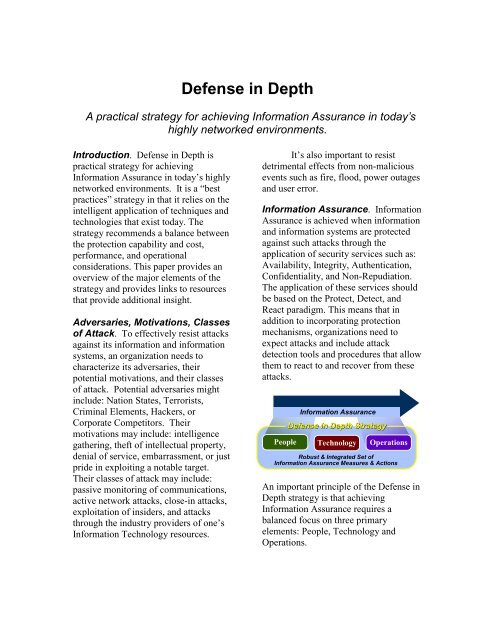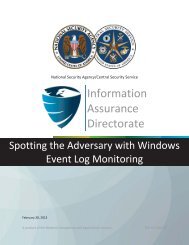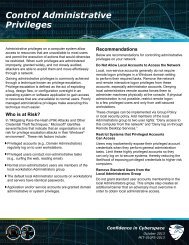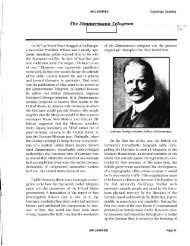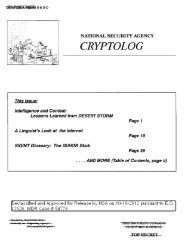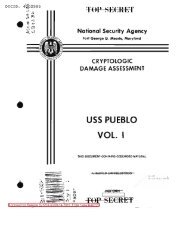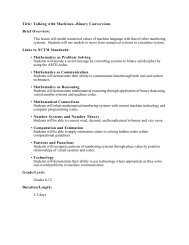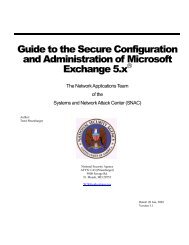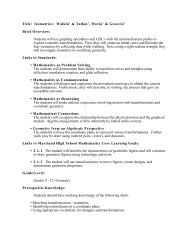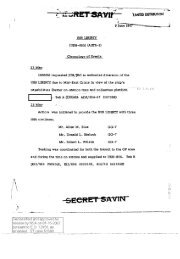Defense in Depth - National Security Agency
Defense in Depth - National Security Agency
Defense in Depth - National Security Agency
You also want an ePaper? Increase the reach of your titles
YUMPU automatically turns print PDFs into web optimized ePapers that Google loves.
<strong>Defense</strong> <strong>in</strong> <strong>Depth</strong><br />
A practical strategy for achiev<strong>in</strong>g Information Assurance <strong>in</strong> today’s<br />
highly networked environments.<br />
Introduction. <strong>Defense</strong> <strong>in</strong> <strong>Depth</strong> is<br />
practical strategy for achiev<strong>in</strong>g<br />
Information Assurance <strong>in</strong> today’s highly<br />
networked environments. It is a “best<br />
practices” strategy <strong>in</strong> that it relies on the<br />
<strong>in</strong>telligent application of techniques and<br />
technologies that exist today. The<br />
strategy recommends a balance between<br />
the protection capability and cost,<br />
performance, and operational<br />
considerations. This paper provides an<br />
overview of the major elements of the<br />
strategy and provides l<strong>in</strong>ks to resources<br />
that provide additional <strong>in</strong>sight.<br />
Adversaries, Motivations, Classes<br />
of Attack. To effectively resist attacks<br />
aga<strong>in</strong>st its <strong>in</strong>formation and <strong>in</strong>formation<br />
systems, an organization needs to<br />
characterize its adversaries, their<br />
potential motivations, and their classes<br />
of attack. Potential adversaries might<br />
<strong>in</strong>clude: Nation States, Terrorists,<br />
Crim<strong>in</strong>al Elements, Hackers, or<br />
Corporate Competitors. Their<br />
motivations may <strong>in</strong>clude: <strong>in</strong>telligence<br />
gather<strong>in</strong>g, theft of <strong>in</strong>tellectual property,<br />
denial of service, embarrassment, or just<br />
pride <strong>in</strong> exploit<strong>in</strong>g a notable target.<br />
Their classes of attack may <strong>in</strong>clude:<br />
passive monitor<strong>in</strong>g of communications,<br />
active network attacks, close-<strong>in</strong> attacks,<br />
exploitation of <strong>in</strong>siders, and attacks<br />
through the <strong>in</strong>dustry providers of one’s<br />
Information Technology resources.<br />
It’s also important to resist<br />
detrimental effects from non-malicious<br />
events such as fire, flood, power outages<br />
and user error.<br />
Information Assurance. Information<br />
Assurance is achieved when <strong>in</strong>formation<br />
and <strong>in</strong>formation systems are protected<br />
aga<strong>in</strong>st such attacks through the<br />
application of security services such as:<br />
Availability, Integrity, Authentication,<br />
Confidentiality, and Non-Repudiation.<br />
The application of these services should<br />
be based on the Protect, Detect, and<br />
React paradigm. This means that <strong>in</strong><br />
addition to <strong>in</strong>corporat<strong>in</strong>g protection<br />
mechanisms, organizations need to<br />
expect attacks and <strong>in</strong>clude attack<br />
detection tools and procedures that allow<br />
them to react to and recover from these<br />
attacks.<br />
Information Assurance<br />
<strong>Defense</strong> In <strong>Depth</strong> Strategy<br />
People Technology Operations<br />
Robust & Integrated Set of<br />
Information Assurance Measures & Actions<br />
An important pr<strong>in</strong>ciple of the <strong>Defense</strong> <strong>in</strong><br />
<strong>Depth</strong> strategy is that achiev<strong>in</strong>g<br />
Information Assurance requires a<br />
balanced focus on three primary<br />
elements: People, Technology and<br />
Operations.
People. Achiev<strong>in</strong>g Information<br />
Assurance beg<strong>in</strong>s with a senior level<br />
management commitment (typically at<br />
the Chief Information Officer level)<br />
based on a clear understand<strong>in</strong>g of the<br />
perceived threat. This must be followed<br />
through with effective Information<br />
Assurance policies and procedures,<br />
People<br />
Information Assurance<br />
<strong>Defense</strong> In <strong>Depth</strong> Strategy<br />
• Policies & Procedures<br />
• Tra<strong>in</strong><strong>in</strong>g & Awareness<br />
• System <strong>Security</strong><br />
Adm<strong>in</strong>istration<br />
Technology<br />
Operations<br />
• Physical <strong>Security</strong><br />
• Personnel <strong>Security</strong><br />
• Facilities<br />
Countermeasures<br />
Hire Good People —Tra<strong>in</strong> & Reward Them Well<br />
Penalize Unauthorized Behavior<br />
assignment of roles and responsibilities,<br />
commitment of resources, tra<strong>in</strong><strong>in</strong>g of<br />
critical personnel (e.g. users and system<br />
adm<strong>in</strong>istrators), and personal<br />
accountability. This <strong>in</strong>cludes the<br />
establishment of physical security and<br />
personnel security measures to control<br />
and monitor access to facilities and<br />
critical elements of the Information<br />
Technology environment.<br />
Technology. Today, a wide range of<br />
technologies are available for provid<strong>in</strong>g<br />
Information Assurance services and for<br />
detect<strong>in</strong>g <strong>in</strong>trusions. To <strong>in</strong>sure that the<br />
right technologies are procured and<br />
deployed, an organization should<br />
establish effective policy and processes<br />
People<br />
Information Assurance<br />
<strong>Defense</strong> In <strong>Depth</strong> Strategy<br />
• IA Architecture<br />
• IA Criteria<br />
(<strong>Security</strong>, Interoperability,<br />
PKI)<br />
Technology<br />
Operations<br />
• Acquisition/Integration of<br />
Evaluated Products<br />
• System Risk Assessment<br />
for technology acquisition. These<br />
should <strong>in</strong>clude: security policy,<br />
Information Assurance pr<strong>in</strong>ciples,<br />
system level Information Assurance<br />
architectures and standards, criteria for<br />
needed Information Assurance products,<br />
acquisition of products that have been<br />
validated by a reputable third party,<br />
configuration guidance, and processes<br />
for assess<strong>in</strong>g the risk of the <strong>in</strong>tegrated<br />
systems. The <strong>Defense</strong> <strong>in</strong> <strong>Depth</strong> strategy<br />
recommends several Information<br />
Assurance pr<strong>in</strong>ciples. These <strong>in</strong>clude:<br />
a) <strong>Defense</strong> <strong>in</strong> Multiple Places. Given<br />
that adversaries can attack a target<br />
from multiple po<strong>in</strong>ts us<strong>in</strong>g either<br />
<strong>in</strong>siders or outsiders, an organization<br />
needs to deploy protection<br />
mechanisms at multiple locations to<br />
resist all classes of attacks. As a<br />
m<strong>in</strong>imum, these defensive “focus<br />
areas” should <strong>in</strong>clude:<br />
People<br />
Defend the<br />
Network &<br />
Infrastructure<br />
Information Assurance<br />
<strong>Defense</strong> In <strong>Depth</strong> Strategy<br />
Technology<br />
Defend the<br />
Enclave<br />
Boundary<br />
Defend the<br />
Comput<strong>in</strong>g<br />
Environment<br />
Operations<br />
<strong>Defense</strong> <strong>in</strong> <strong>Depth</strong> Focus Areas<br />
Support<strong>in</strong>g<br />
Infrastructures<br />
Detect &<br />
KMI/PKI Respond<br />
• Defend the Networks and Infrastructure<br />
- Protect the local and wide area<br />
communications networks (e.g. from<br />
Denial of Service Attacks)<br />
- Provide confidentiality and <strong>in</strong>tegrity<br />
protection for data transmitted over<br />
these networks (e.g. use encryption and<br />
traffic flow security measures to resist<br />
passive monitor<strong>in</strong>g)<br />
• Defend the Enclave Boundaries (e.g.<br />
deploy Firewalls and Intrusion<br />
Detection to resist active network<br />
attacks)<br />
Application of Evaluated Products and Solutions<br />
Support of a Layered <strong>Defense</strong> Strategy
• Defend the Comput<strong>in</strong>g Environment<br />
(e.g. provide access controls on hosts<br />
and servers to resist <strong>in</strong>sider, close-<strong>in</strong>,<br />
and distribution attacks).<br />
b) Layered <strong>Defense</strong>s. Even the best<br />
available Information Assurance<br />
products have <strong>in</strong>herent weaknesses.<br />
So, it is only a matter of time before<br />
an adversary will f<strong>in</strong>d an exploitable<br />
Examples of Layered <strong>Defense</strong>s<br />
Class of First L<strong>in</strong>e of Second L<strong>in</strong>e of<br />
Attack <strong>Defense</strong> <strong>Defense</strong><br />
Passive<br />
Active<br />
Insider<br />
Close-In<br />
Distribution<br />
L<strong>in</strong>k & Network Layer<br />
Encryption and<br />
Traffic Flow <strong>Security</strong><br />
<strong>Security</strong> Enabled<br />
Applications<br />
Defend the Enclave Defend the Comput<strong>in</strong>g<br />
Boundaries<br />
Environment<br />
Physical and Personnel Authenticated Access<br />
<strong>Security</strong><br />
Controls, Audit<br />
Physical and Personnel Technical Surveillance<br />
<strong>Security</strong><br />
Countermeasures<br />
Trusted Software Run Time Integrity<br />
Development and Controls<br />
Distribution<br />
vulnerability. An effective<br />
countermeasure is to deploy multiple<br />
defense mechanisms between the<br />
adversary and his target. Each of<br />
these mechanisms must present<br />
unique obstacles to the adversary.<br />
Further, each should <strong>in</strong>clude both<br />
“protection” and “detection”<br />
measures. These help to <strong>in</strong>crease<br />
risk (of detection) for the adversary<br />
while reduc<strong>in</strong>g his chances of<br />
success or mak<strong>in</strong>g successful<br />
penetrations unaffordable.<br />
Deploy<strong>in</strong>g nested Firewalls (each<br />
coupled with Intrusion Detection) at<br />
outer and <strong>in</strong>ner network boundaries<br />
is an example of a layered defense.<br />
The <strong>in</strong>ner Firewalls may support<br />
more granular access control and<br />
data filter<strong>in</strong>g.<br />
c) Specify the security robustness<br />
(strength and assurance) of each<br />
Information Assurance component as<br />
a function of the value of what’s it is<br />
protect<strong>in</strong>g and the threat at the po<strong>in</strong>t<br />
of application. For example, it’s<br />
often more effective and<br />
operationally suitable to deploy<br />
stronger mechanisms at the network<br />
boundaries than at the user desktop.<br />
d) Deploy robust key management and<br />
public key <strong>in</strong>frastructures that<br />
support all of the <strong>in</strong>corporated<br />
Information Assurance technologies<br />
and that are highly resistant to attack.<br />
This latter po<strong>in</strong>t recognizes that these<br />
<strong>in</strong>frastructures are lucrative targets.<br />
e) Deploy <strong>in</strong>frastructures to detect<br />
<strong>in</strong>trusions and to analyze and<br />
correlate the results and react<br />
accord<strong>in</strong>gly. These <strong>in</strong>frastructures<br />
should help the “Operations” staff to<br />
answer questions such as: Am I<br />
under attack? Who is the source?<br />
What is the target? Who else is<br />
under attack? What are my options?<br />
Operations. The operations leg<br />
focuses on all the activities required to<br />
susta<strong>in</strong> an organization’s security<br />
posture on a day to day basis.
People<br />
• <strong>Security</strong> Policy<br />
Information Assurance<br />
<strong>Defense</strong> In <strong>Depth</strong> Strategy<br />
• Certification and<br />
Accreditation<br />
Technology<br />
• <strong>Security</strong> Mgmt.<br />
• Key Management<br />
• Read<strong>in</strong>ess<br />
Assessments<br />
Operations<br />
• ASW&R<br />
Enforce <strong>Security</strong> Policy<br />
Respond Quickly to Intrusions<br />
Restore Critical Services<br />
• Recovery &<br />
Reconstitution<br />
These <strong>in</strong>clude:<br />
a) Ma<strong>in</strong>ta<strong>in</strong><strong>in</strong>g visible and up to date<br />
system security policy<br />
b) Certify<strong>in</strong>g and accredit<strong>in</strong>g changes to<br />
the Information Technology<br />
basel<strong>in</strong>e. The C&A processes should<br />
provide the data to support “Risk<br />
Management” based decisions.<br />
These processes should also<br />
acknowledge that a “risk accepted by<br />
one is a risk shared by many” <strong>in</strong> an<br />
<strong>in</strong>terconnected environment.<br />
c) Manag<strong>in</strong>g the security posture of the<br />
Information Assurance technology<br />
(e.g. <strong>in</strong>stall<strong>in</strong>g security patches and<br />
virus updates, ma<strong>in</strong>ta<strong>in</strong><strong>in</strong>g access<br />
control lists)<br />
d) Provid<strong>in</strong>g key management services<br />
and protect<strong>in</strong>g this lucrative<br />
<strong>in</strong>frastructure<br />
e) Perform<strong>in</strong>g system security<br />
assessments (e.g. vulnerability<br />
scanners, RED teams) to assess the<br />
cont<strong>in</strong>ued “<strong>Security</strong> Read<strong>in</strong>ess”<br />
f) Monitor<strong>in</strong>g and react<strong>in</strong>g to current<br />
threats<br />
g) Attack sens<strong>in</strong>g, warn<strong>in</strong>g, and<br />
response<br />
h) Recovery and reconstitution<br />
Additional Resources. The <strong>National</strong><br />
<strong>Security</strong> <strong>Agency</strong>, with support from<br />
other U.S. Government Agencies and<br />
U.S. Industry, has undertaken a number<br />
of <strong>in</strong>itiatives to support the <strong>Defense</strong> <strong>in</strong><br />
<strong>Depth</strong> strategy. These <strong>in</strong>clude:<br />
a) The Information Assurance<br />
Technical Framework. This<br />
document provides detailed<br />
Information Assurance guidance for<br />
each of the <strong>Defense</strong> <strong>in</strong> <strong>Depth</strong> focus<br />
areas. It is available at<br />
https://www.iad.gov/library/iacf.cfm<br />
b) The <strong>National</strong> Information Assurance<br />
Partnership (NIAP). This is a<br />
partnership between NSA and NIST<br />
to foster the development of the<br />
International Common Criteria (an<br />
ISO standard) and to accredit<br />
commercial laboratories to validate<br />
the security functions <strong>in</strong> vendor’s<br />
products. Information on this<br />
activity is available at<br />
http://niap.nist.gov<br />
c) Common Criteria Protection Profiles.<br />
These are documents that<br />
recommend security functions and<br />
assurance levels us<strong>in</strong>g the Common<br />
Criteria. They are available for a<br />
wide range of commercially<br />
available technologies and can be<br />
accessed at the IATF or the NIAP<br />
web sites listed above.<br />
d) List of Evaluated Products. These<br />
are lists of commercial Information<br />
Assurance products that have been<br />
evaluated aga<strong>in</strong>st the Common<br />
Criteria. The lists are ma<strong>in</strong>ta<strong>in</strong>ed by<br />
NIST and are available at the NIAP<br />
web site.<br />
e) Configuration Guidance. These<br />
documents, be<strong>in</strong>g prepared by NSA,<br />
conta<strong>in</strong> recommended configurations<br />
for a variety of commonly used<br />
commercial products.
f) Glossary of Terms. The <strong>National</strong><br />
Information Systems <strong>Security</strong><br />
(INFOSEC) Glossary, dated<br />
September 2000, can be found at:<br />
http://www.nstissc.gov/Assets/pdf/4<br />
009.pdf<br />
Feedback. Please address questions or<br />
comments on this paper by email to<br />
SNAC@radium.ncsc.mil<br />
or by mail to:<br />
<strong>National</strong> <strong>Security</strong> <strong>Agency</strong> Attention:<br />
Information Assurance Solutions Group – STE 6737<br />
9800 Savage Road<br />
Fort Meade, MD 20755-6737


